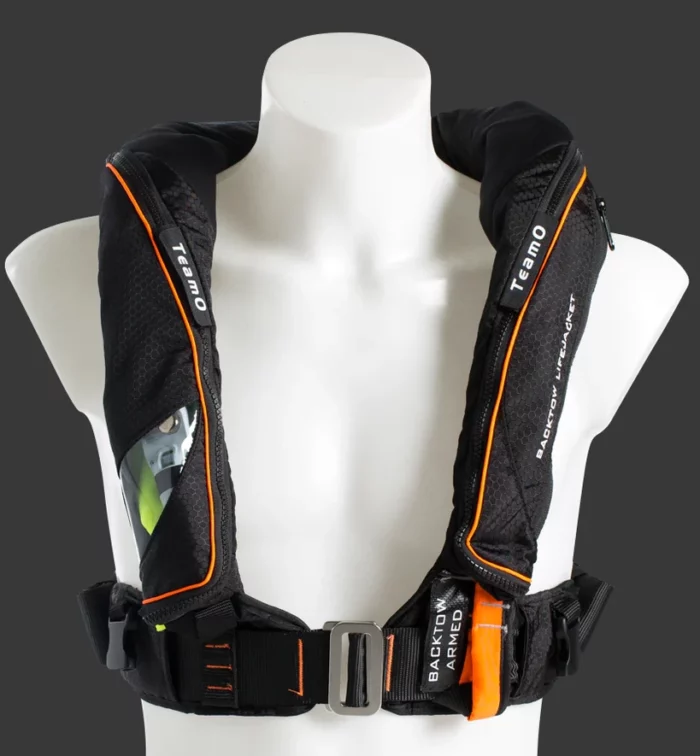
Back in 2017, several members asked for my thoughts on the then-prototype TeamO Backtow lifejacket/harness, so I wrote an article that was generally positive.
Fast forward to 2025 and TeamO are now a real company shipping lifejackets with harnesses and promoting them aggressively as a solution to drowning while being dragged after falling overboard.
And others, including Sailing Uma and Chris Stanmore-Major, have embraced the Backtow™ as the solution.
Are these claims well placed? Here are my thoughts:
Manual Deploy
First off, the now-available TeamO jacket differs from the prototype in that activating the Backtow™ feature requires the crew overboard (COB) to pull a handle. (For comparison, you can see the prototype in action here.)
Activation Practicality?
So my key question, which all the marketing and breathless reviews seem to be ignoring, is will a COB actually be able to activate the Backtow after falling in?
Or will the COB be disabled by the force and volume of the water hitting them in the face, combined with the tension on the tether, to the point that they can’t pull the handle?

Solid and important advice, thank you.
Thank you John for the review.
The number one rule “Don’t Fall Over” is the best. On our boat the second is “Always have you life jacket on” our 3rd is “Make sure someone sees you fall” that means never ever leave the cockpit with out some watching you, turning on the spreader lights and wearing communication headsets when anyone is on deck at night, our 4th rule is “Stop the boat immediately by turning away from the boom”
Hi Leo,
I agree, don’t go over the side is the number one.
That said, albeit surprisingly to many, I disagree on many of the others on your list:
https://www.morganscloud.com/2025/03/04/20-practical-tips-for-better-watchkeeping/ (see #8 and #9)
And, although we used to believe in the quick stop and practice it regularly, some years ago, after a nasty experence, Phyllis and I decided that it was deeply flawed for short handed crews. Here’s why, and what we replaced quick stop with:
https://www.morganscloud.com/2018/03/22/person-overboard-recovery-is-the-quick-stop-bogus/
https://www.morganscloud.com/2018/03/30/person-overboard-recovery-making-the-most-of-ais-beacons/
Thanks John,
I should have been more clear. I was referring to the situation you were discussing in which a crew is overboard and tethered to the boat going 6-8knots in seas. In what I’ve read the COB only has minutes to live so it seems critical to get the boat speed down asap. I guess the purpose of the new Team O jacket is to attempt to prolong how long a COB can stay alive while tethered to boat.
In re reading your articles I agree COB situations when the COB is not tethered to the boat you have more time, esp if the COB has AIS and a PLB and therefore getting the speed down overly quickly is not worth the risk.
Hi Again Leo,
On rereading I realized my answer sounded a bit harsh, sorry. The thing I wanted to share is that although I know that your rules are adopted by many, particularly these days, they do have downsides in the area of rest and night vision. And after many years of believing in it, both Phyllis and I have serious reservations about the quick stop, at least for short handed crews. And said reservations have become even more concerning to us over the last two summers during practices of COB pickup. More coming in another article.
Great article, stay on the boat is the number one goal, build systems that will accomplish this at all cost. Thank you for preparing and sharing it. Enjoy the day.
Hi John,
I think it’s good to know this jacket does exists.
We have 8 spinlock vests on board. They are put to a rough use, except for the 2 for visitors. For kids, the Team-O does not provide any value as there is no kids size. And kids are prone to panicking anyways, therefore, I’m not sure it provides any added value to be able to deploy the back tow. I’m not sure that they could with the forces at play or that they would have the presence of mind to do so. Maybe if it was automatic on a kids’ vest, I could see some appeal in it. Our kids don’t get much outside the cockpit when we are underway, but fishing is also our way of life and accidents are accidents. At least they have the vest and clipping reflex when getting out of the cockpit. For adults, I can see how one might appreciate the choice not to deploy the back tow in certain scenarios, but there is no added value for the unconscious person in a vest like this one. Like anything for safety, a false sense of security may be inherently provided with the product, as if someone can then just wait if they fall overboard… One video made it sound like that. But, providing one if strong enough to deploy the back tow with the forces at play, it’s hard to argue with the fact that it may indeed provide more time alive if unclipping is not an option (no MOB AIS device and certain death is coveted if you do unclip). Even with our MOB AIS device, once hanging over the side, perhaps I would wish I had a backtow option on my high tech vest before simply attempting to unclip. In any case, I’m glad the vests we have on board are still good for a couple more years because I don’t have to choose anything today!
Thank you for your analysis,
Hi Marie Eve,
Yes, I think the key here is that there is certainly value in Backtow, but it’s not a panacea.
“But it’s not a panacea” I think that is the point. Since back tow becomes an option once you are at an extreme, it has value. The fact that once deployed you can nolonger severe your connection is a minus. And if the fall incapcitates you, any of the release options have also become moot. I tend to look at all sailing thru the lens of shorthanded off shore, but for all the boats sailing with larger crews I think you would be happier staying attached rather than hoping for a successful pick up. COB AIS is a huge leap forward. Our practice retrieving a COB in sheltered water has shown me that being towed forward through the water even at slow seeds is just plain bad. I recommend if you find yourself in a life sling, turn around. Just being pulled to the boat could result in secondary drowning. Best solution: stay on the boat. As Paul Tramel says “the water is lava”.
Hi Carl, you are right, not being able to severe the connection once deployed is perhaps the biggest minus… The water is lava, I think I’ll start saying that!
I think we have to be careful of stacking risk, upon risk as it is inherently results in a probability that is insignificant, especially if other controls like near centre line jackstays are in place. I expect if I fall overboard while attached to the boat, the crew will bring the boat to a stop, or significantly reduced speed, to aid my recovery in a timely manner. If everyone on board was unaware and I got pulled along at speed then what happens will depend on so many other factors. Risk stacking quickly leads to irrelevant focus and there are so many other barriers that can be strengthened long before a COB is going to be towed at speed for any significant time.
My personal opinion is that the back tow capability is not worth the risk. The release mechanism to enable back tow is just another factor that needs to be managed which is way down the priority list.
Having said that, I can see a case for two up sailing, where a PLB AIS or alert system, might not activate and discovery of COB could be longer, hence topped at speed risk reduction may benefit from back tow functionality. However, jack stay positioning can solve that risk as well.
Hi Alastair,
That’s certainly a rational position to take. One thought. Phyllis and I did some testing the last couple of summers and one of the things we worked on was slowing the boat quickly. And we found it a lot harder than we expected to get the speed under 2 knots in a reasonable period and even harder to keep it there. In the end we figured it out and now have a drill that I will be sharing in a future article. Anyway, it’s worth practicing, which I suspect you have already done.
Good thoughts John.
We bought the team-o back-tow three years ago. Have not tested and hopefully won’t.
As a mono hull and the risk of capsize is small (not even something I had considered when buying) I decided staying attached to the boat would be my preference. No argument on all your points about ways it won’t work. But as you said, those are the same with all other jacket choices. I like that we have the back tow as an option.
Before buying these we did read all your articles on Jack lines and MOB prevention and other sources and have done our best to make sure we never test them. If someone buys them and does not consider their systems otherwise, there’s nothing to be done for them. And quite frankly after a few years of cruising I’m far more concerned about the number of people who don’t use their life jackets than which jackets they’ve chosen.
Anyways, so far happy customers with the Team-o
Hi Gentry,
Thanks for the feedback on the TeamO, as you say, a good alternative as long as we have done everything we can to reduce drag risk first.